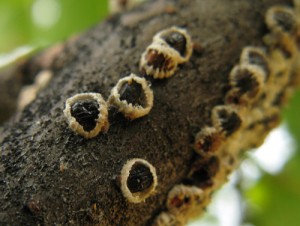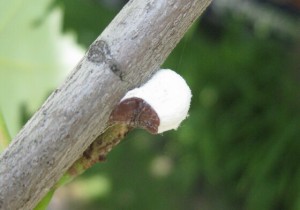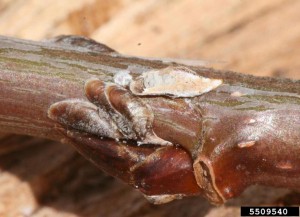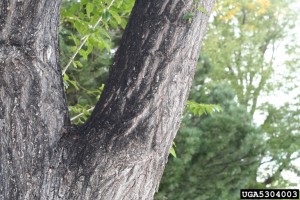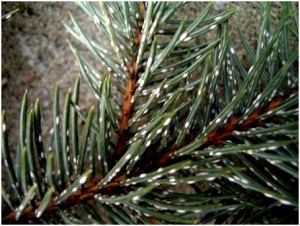Scale Insects
Scale Insects
Many of us don’t really want to look at the scales when we step on them in the morning as we don’t like the numbers we see. But there are some other scales we also don’t like to see, and they are in our trees.
Scale insects appear as little bumps on the twigs, branches, or needles of trees and shrubs in our yards. They don’t move, and so you might not even be aware that they are alive. Scale insects are sap-feeding insects with a shell-like waxy covering that conceals their bodies. Nearly all trees are susceptible and although a few insects don’t pose a problem, in high numbers they can weaken and, in rare cases, even kill trees.
Depending on the species, scale insects may be found on plant stems, twigs, trunks, foliage, or fruit. Most scale insects are small and inconspicuous. The size of scale insects ranges from 1/8 to ½ inch. Colors can vary widely, including white, brown, black, gray and red. Size, shape, and texture also vary with the species. Two common scale insects we are seeing in high numbers right now in east Idaho are the European Elm
Scale on Camperdown Elm and Cottony Scale in maple trees.
Scale insects are generally divided into two categories:
- Soft scales produce a soft, thin, cottony, powdery or waxy layer over themselves that cannot be separated from the insect body.
- Armored scales have a hard, shield-like cover composed of shed skins and wax that conceals the body but is not attached to the body of the insect.
Scale insects feed by sucking sap from trees and shrubs through piercing-sucking mouth parts. Sap feeding by scale insects may cause yellowing or wilting of leaves, stunting or unthrifty appearance of the plants, and eventually death of all or part of the plant when infestations are heavy. Weakened plants may lose vigor and become more susceptible to injury caused by drought, severe winters, attack by other insects (such as borers), or infection by diseases.
While feeding, soft scale insects excrete a sweet, sticky substance called honeydew. Honeydew is a mixture of undigested sugar and water passed through the insect’s digestive system and deposited onto leaves and stems. Honeydew may make the plant appear shiny and wet and also attracts flies, ants, bees, and other insect scavengers. The honeydew may encourage a fungus called sooty mold that gives the plants a characteristic black, “sooty” appearance. Honeydew can foul sidewalk, cars, and houses beneath scale-infested trees.
There are three chemical control strategies for treating infested trees and shrubs: spray dormant oil prior to bud break, apply a contact insecticide in summer when the crawlers are active, or use a systemic insecticide.
Dormant Oil: A thorough application of horticultural oil according to label instructions just prior to bud break in late March or early April (while the plant is dormant) may control scale insects on trees and shrubs. Effective control requires a thorough treatment of all aboveground plant parts.
Summer Sprays: Contact insecticide sprays do not penetrate the protective covering of most scales. Therefore insecticide treatments are most effective when applied during crawler emergence, immediately after egg hatch. The trick is to know when egg hatch is occurring. That is done by visual inspection. Carefully examine the infested plant to see if crawlers are present or shake a branch of the infested plant above a sheet of white paper and examine the paper for crawlers. Or, place double-sided tape around the twigs or branches in affected areas of the plant when crawlers are expected. The tiny insect’s bodies get stuck in the adhesive. A magnifying glass can help with identification. Useful insecticides include insecticidal soap, horticultural oil, malathion, and others.
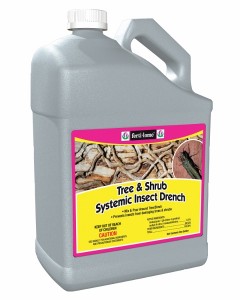 Systemic Insecticides: Fertilome Tree & Shrub Systemic Insect Drench can be applied as a drench around the base of the tree. Acecap 97 systemic implants are inserted into holes bored in the trunk of the tree. Systemic insecticides circulate through the plant and can control both crawlers and adult scales with less impact on natural enemies and less risk of pesticide drift. Check the pesticide label of each product to make sure that the type of scale and the name of the host plant are listed for that product. Always read and follow label instructions on mixing, usage and application safety.
Systemic Insecticides: Fertilome Tree & Shrub Systemic Insect Drench can be applied as a drench around the base of the tree. Acecap 97 systemic implants are inserted into holes bored in the trunk of the tree. Systemic insecticides circulate through the plant and can control both crawlers and adult scales with less impact on natural enemies and less risk of pesticide drift. Check the pesticide label of each product to make sure that the type of scale and the name of the host plant are listed for that product. Always read and follow label instructions on mixing, usage and application safety.
Old scales may remain harmlessly on the plant for some time after the death of the insect. To evaluate the effectiveness of treatments, slide your thumb across a group of scales. If scales are dead, they will be hollow and the coverings will flake off easily. Living scales will leave a colored, wet residue on your thumbnail.
Source: http://www.ipm.iastate.edu/ipm/info/insects/true-bugs/scale-insects



